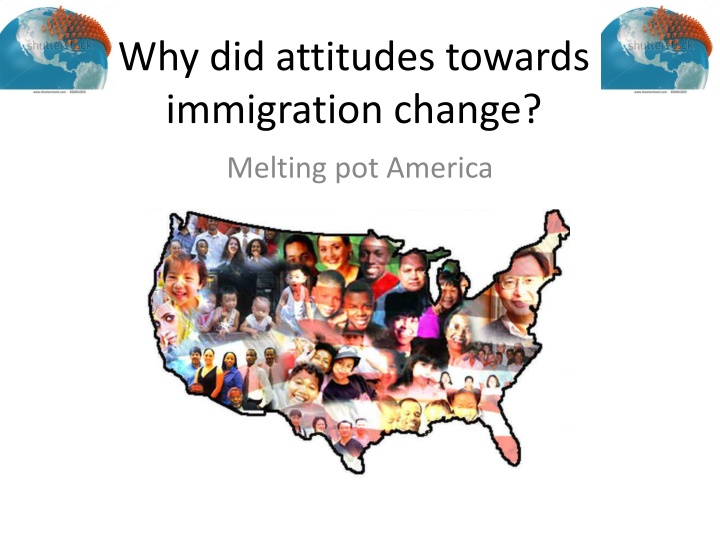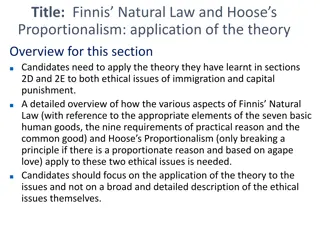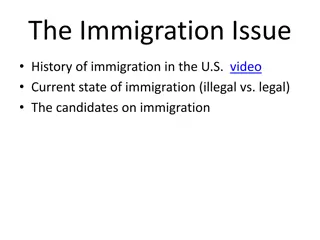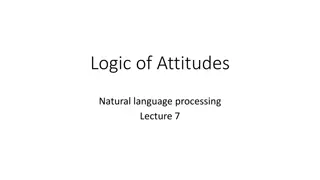Evolution of Immigration Attitudes in the Melting Pot America
Attitudes towards immigration changed in America due to various factors such as social and religious fears, the implementation of restrictive legislation like the Emergency Immigration Law in 1921, and the National Origins Act in 1924. These changes marked a shift from the previous Open Door Policy, with concerns about increased immigration levels and favoritism towards Old Immigrants influencing the shift. Evaluating isolated factors like racism and fear of revolution helps understand the main reasons behind the stricter immigration policies of the 1920s.
Download Presentation

Please find below an Image/Link to download the presentation.
The content on the website is provided AS IS for your information and personal use only. It may not be sold, licensed, or shared on other websites without obtaining consent from the author.If you encounter any issues during the download, it is possible that the publisher has removed the file from their server.
You are allowed to download the files provided on this website for personal or commercial use, subject to the condition that they are used lawfully. All files are the property of their respective owners.
The content on the website is provided AS IS for your information and personal use only. It may not be sold, licensed, or shared on other websites without obtaining consent from the author.
E N D
Presentation Transcript
Why did attitudes towards immigration change? Melting pot America
What is argument? ARGUMENT Up to 10 marks can be awarded 0-1 marks The style is narrative and descriptive There is little or no clear attempt to answer the question. 2-3 marks The style is mainly narrative and descriptive. There are some brief attempts to answer the question. 4-5 marks The style demonstrates some analysis, though there may still be some narrative. There is use of evidence to answer the question. 6-7 marks The style is analytical, with the evidence used to develop and support a line of argument. The line of argument is focused directly on the question. 8-10 marks The evidence is integrated into a sustained analysis. The argument is sustained and balanced, with some awareness of alternative interpretations and/or historical debate.
Full marks intro & conclusion: The introduction clearly sets the issue in its wider context, indicates relevant factors and demonstrates a solid line of argument. There is a coherent development directly focused on the question. The conclusion is balanced, summarising the arguments and coming to an overall judgement directly related to the question.
CONTEXT USA had an Open Door Policy until the 1920s when new legislation was passed to restrict entry. 1921 Emergency Immigration Law, 1924 National Origins Act. Both put a quota on how many could enter the country. Perhaps triggered by a peak in immigration levels in 1900-1910 almost 9million! Favour shown towards Old Immigrants
Evaluation questions isolated factor 2011: To what extent was racism the main reason for changing attitudes towards immigration in the 1920s? 2009: To what extent was the increase in hostility towards immigrants in the USA during the 1920s due to fear of revolution?
The question is asking you to judge whether this factor is the main cause of stricter immigration in the 1920s or if there are other causes. You must then RANK these causes in order of importance in your essay and ARGUE why they are important or not as important as the isolated factor.
Why did attitudes towards immigration change? Social fears Religious fears Isolationism & WWI Economic fears Anti-Immigration attitudes before 1920 Fear of Communism/ Revolution
RACISM The cultural differences displayed in language, clothing, religion led to ill-informed racism. Californian laws against Asian immigrants were clearly racist in outlook. Old V New immigrants - WASP America worried. New immigrants were not familiar with democracy so were perceived as a political threat. New immigrants looked different. Rebirth of KKK appealing to 100% Americanism. New immigrants were believed to be inferior people and threatened traditional values . Anti Immigration legislation of 1920s strongly biased against new immigrants from southern and eastern Europe.
POLITICAL FEARS - Communism Americans were fiercely proud of their capitalist and democratic ideals. Immigrants associated with anarchy. Context of Russian Revolution terrified Capitalist America would succumb to revolution the Red Scare based on speculation and paranoia. However, fears realised with Palmer Raids August 1919 6000 foreign radicals arrested in 1920, 600 deported and forced to sign confessions. Most immigrants were more concerned with adjusting to new home rather than organising subversion.
Attitudes before 1920s Racism and legal restriction of immigrants had occurred before the 1920s. 1884 The Immigration Restriction League founded in Boston US will be swamped by lesser breeds 1882 Federal Immigration Act restricted lunatics, paupers and convicts a concern of burden on society or threat to law & order 1882 Chinese Exclusion Act evidently a racially exclusive law to exclude. Arguably, this proves that restrictive attitudes to immigration existed long before 1920s, the numbers and type were broadened in the 1920s. An undercurrent of prejudice and racism was already in existence.
WWI/Isolationism WWI acted as a catalyst US propaganda demonised the Germans, encouraged patriotism -> resulted in Xenophobia German language stopped in schools Sauerkraut became Liberty Cabbage WWI encouraged racial and national stereotyping. Stereotyped associations became apparent suspected communist if you were Russian Isolationist stance had been taken by the government and people who regretted their involvement in European affairs -> Protect our ethnicity, curb immigration of aliens . Wilson declared that USA should not be involved in a European civil war hence their reluctance to join League of Nations.
100% Americanism Nativism arguments Nativists are those born in America Nativists view New wave as : illiterate and unskilled escaping from civil war, poverty and persecution their diversity was a threat Cultural clothing made them stand out they looked out of place in modern America Many malnourished with deformities Most congregated in urban areas Pseudo-scientific racism: prejudice evident Saturday Evening Post Kenneth Roberts Polish Jews human parasites good for nothing mongrels of central and eastern Europe Prejudice amongst middle class for job competition mistrust not a majority view but a dangerous influence
SOCIAL FEARS Rising crime rates blamed on immigrants in ghettoes. Fears that they were not integrating. However, no greater instances than nativist neighbourhoods Charities recognised that crime was often out of desperation to provide for families in abhorrent living conditions Sacco and Vanzetti electric chair in 1927 accused of murder and armed robbery very little evidence besides anarchist links Fanned the fires of prejudice in rural communities
ECONOMIC FEARS Fears that immigrants would increase job competition after WWI boom declined. Trade Unions felt that Italian immigrants were strike breakers they even called for a literacy test! Debated 32 times in Congress. Greatly increased resentment towards immigrants. However many immigrants did the low paid, unskilled jobs that Nativist Americans didn't want!
RELIGIOUS FEARS Hostility towards Catholic and Jewish immigrants Polish Jews human parasites
Racism/Political Congressman James McClintic, Democrat Oklahoma: I say the class of immigrants coming to the shores of the United States at this time are not the kind of people we want as citizens in this country.
Racism/Political Nicolas Vanzetti was tried in Massachusetts twice, first for bank robbery and then for murder. In the first trial, Webster Thayer, who was the judge in both cases, told the jury: This man, although he may not have actually committed the crime . . ., is nevertheless morally culpable, because he is the enemy of our existing institutions.
Throughout the History of the United States, there had been an open door policy which had let in immigrants from around the world almost without question. American industrial expansion had been made possible by the ready availability of cheap labour in the form of huge numbers of migrants from the 1860s onwards. In the 1920s, the USA ended the open door policy, and the effect of the 1921 and 1924 Immigration Acts was to restrict the number of immigrants from each country into the USA. These measures virtually stopped mass immigration to the United States until the 1960s. The reasons the US Government brought in the measures will be discussed under three headings: social, political, and influences from outside the USA.























